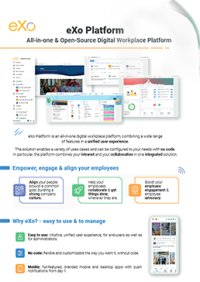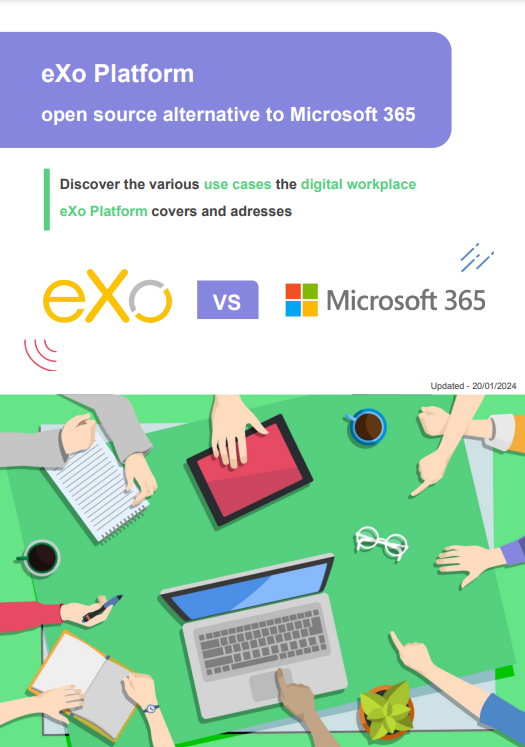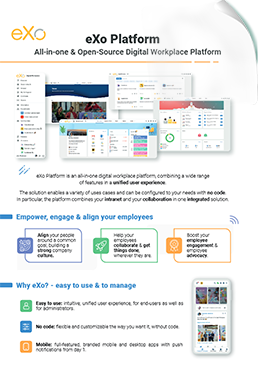

FREE DATASHEET
Download the eXo Platform Datasheet and discover all the features and benefits
Faced with the proliferation of tools, information overload, and the growing complexity of organizations, local authorities—whether a city, departmental, regional council, or public administration—are seeking to simplify and humanize their communication while making collaboration easier.
Today, the modern intranet has become an essential lever to meet these challenges. More than just an internal website, it is a true collaborative workplace where employees can exchange ideas, access information, share knowledge, and take an active part in the life of their organization.

Between remote work, the quick development of digital tools, and the growing need for a responsive public service, local governements and public aministrations have to rethink how they operate and start their digital transformation. What if the modern intranet was the solution to these challenges?
Long perceived as a simple space for storing or spresding information, the intranet has deeply evolved into an interactive, engaging and user-centered platform. It connects teams, streamlines communication, simplifies processes and helps to capture and share knowledge. This tool is a lever for restoring meaning to the collective.
For public organizations, often dealing with geographically dispersed services, a diversity of professions and complex internal communication challenges, a modern intranet is a transformative and structuring project.
In this article, we will talk about the main challenges of a modern intranet in public sector:
Communication lies at the heart of any public organization.
Administrative staff, technical departments, elected officials, communications, HR…everyone has to collaborate, sometimes remotely, often urgently, but always with the same goal: to provide public services that are as clos as possible to citizens.
In practice, however messages get lost in overloaded email inboxes, files are duplicated, and meetings multiply due to a lack of coordination. The result? Lost time, frustration, and siloed communication.
This is precisely where the modern intranet demonstrates its full value.
When well-designed and adapted to the organization, it becomes the central hub for collaboration. With collaborative workspaces, newsfeed, personalized notifications, and co-editing tools, teams can communicate seamlessly and work together across departments.
The outcome: smoother communication, improved mutual understanding, and a more positive workplace climate.
And because field workers and elected officials have also to stay connected, a modern intranet now includes mobile applications, enabling access to information and collaboration from any device, anywhere.
In public organizations, information is everywhere—internal notes, memos, decisions, events, procedures, HR resources… When all this circulates through emails or scattered tools, information overload quickly becomes overwhelming and stressful.
A modern intranet provides a simple and efficient answer: a single, structured space to centralize, organize and share information. No more overloading inboxes or lost documents—the intranet becomes the internal communication hub.
Through thematic spaces, service-specific feeds, and personalized notifications, every employee accesses the information that matters most, without being overloaded.
Leadership teams can share official communications, departments can showcase their projects, and everyone can easily find what they need.
Key benefits include:
The intranet thus becomes a true driver of trust and equity within the organization.
For many public organizations, employees’ daily work is still marked by lengthy, fragmented or redundant processes: paper forms to sign, multiple approval steps, repetitive administrative tasks…
A modern intranet simplifies and digitizes these internal processes, centralizing them within a single, smooth and collaborative workplace. Leave requests, expense claims, equipment orders—all are managed through automated workflows, allowing each person to track progress in real time. No more chasing signatures or printing forms: everything is online, transparently.
This centralization makes employees’ lives easier and frees support services (HR, finance, communications…) to focus on higher-value tasks. It also strengthens organizational consistency, as every process becomes traceable, measurable and continuously improvable.

Open Source Alternative to Microsoft 365
Empower your organization with eXo Platform to break free from Microsoft dependencies and enhance collaboration with innovative solutions
Open Source Alternative to Microsoft 365
Empower your organization with eXo Platform to break free from Microsoft dependencies and enhance collaboration with innovative solutions
Knowledge is everywhere in a public administration: technical notes, internal procedures, best practices, contact lists, archives… Yet it is often scattered across teams, personal drives or email inboxes. When someone leaves or retires, valuable knowledge can be lost.
A modern intranet serves as a shared knowledge base: it centralizes, organizes and highlights information, making it accessible, relevant and sustainable.
Document management, internal wikis, FAQs and dedicated business spaces… everything helps to capture and share institutional knowledge. Employees can easily:
Knowledge thus becomes a collective asset, rather than an individual one.
Adaptable intranet also answers to the specific needs of each department—HR, finance, urban planning, technical services, communications, elected officials—by organizing around uses rather than rigid hierarchies. This transversality fosters understanding and collaboration across departments.
Digital transformation in public sector is, above all, a human endeavor.
A well-designed and dynamic intranet becomes a lever of engagement, a vehicle for recognition and a driver of cohesion. An informed, connected and valued employee is one who feels truly involved in the organization.
An intuitive and ergonomic interface, smooth navigation, and personalized spaces where each person finds their news, tools and interactions—a user-centered intranet, based on a genuine “employee portal” approach simplifies daily work, strengthens autonomy, and promotes long-term adoption of the solution.
The modern intranet is no longer just a top-down communication tool—it is an open space for dialogue, exchange and participation. Through a decentralized communication approach, every employee can become an active contributor, share experiences, highlight initiatives or engage with ongoing projects.
Activity feeds, idea boxes, internal surveys, feedbacks, and collaborative challenges all features foster participation and transparency. This openness builds stronger links between departments and promotes proximity between leadership, managers and frontline workers.
Giving employees a voice means creating a more open, horizontal and genuine internal communication culture.
By encouraging sharing and contribution, the intranet gradually transforms internal culture.
Employees take ownership of the tool, create content and develop a genuine sense of belonging. It becomes a true digital workplace —a place to stay informed, exchange ideas and connect around a shared mission.
In a context of geopolitical instability and constantly increasing cyberattacks, data security and digital sovereignty have become key challenges for local governments and public adminidtrations.
Centralizing exchanges and documents within a single platform ensures better information system consistency through:
This approach reduces risks of data leaks or loss and creates a digital trust environment within the organization.
For local authorities, controlling their data means ensuring their digital independence.
Choosing an open-source solution, hosted in Europe or on premise, such as eXo Platform, ensures the confidentiality, transparency and sustainability of their digital environment.
It also allows CIOs and executive teams to keep full control over their information systems, free from U.S. extraterritorial laws, while encouraging cooperation and mutualization between local authorities.
This pragmatic and sovereign approach provides a sustainable alternative to proprietary solutions, strengthens technological autonomy, and fully aligns with the core values of the public service: independence, security, transparency and accountability.
Securing data also means supporting employees—training them, raising awareness of best practices, and making everyone an active player in cybersecurity.
In doing so, digital trust becomes part of the organization’s culture, ensuring the intranet remains a safe and reliable space for all.
As public organizations seek to balance efficiency, proximity and digital resilience, the modern intranet stands out as a strategic pillar of their internal transformation.
Beyond technology, it embodies a new way of working together—smoother, more transparent and collaborative.
By connecting people, simplifying processes and valuing knowledge, it restores meaning to public action and strengthens the collective. Yet in a world marked by growing cyberattacks and dependency on proprietary tools, data control has become a critical issue.
A sovereign intranet, based on open source technologies and hosted in Europe or on premise, guarantees the confidentiality, security and sustainability of public data. It is both a strategic and political choice—one rooted in independence, transparency and trust.
Today, cybersecurity is a pillar of organizational trust and a condition for the continuity of public service. By choosing a controlled, secure and scalable solution, public adminsitrations protect their digital assets while asserting their technological autonomy.
Implementing a modern intranet means building a more connected, safer and more sovereign organization, serving employees, elected officials and citizens alike.
Discover how eXo Platform helps local governments and public administrations reduce their dependence on Microsoft 365 through the use case of the Occitanie Region.
And contact us to talk about your collaborative intranet project!

eXo Platform : The Open-Source
Digital Workplace Platform
Download the eXo Platform Datasheet and discover all the features and benefits


Download the eXo Platform Datasheet and discover all the features and benefits
( Your e-mail address will not be published)
I am the communication manager at eXo Platform. I found myself in communications a bit by chance, but this field brings together everything that pationates me: creativity, energy, meetings, collaborative work, sharing and exchanges of good practices. I need to give meaning to what I do and put people at the center of all my actions.